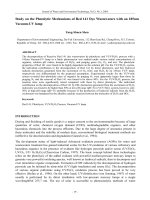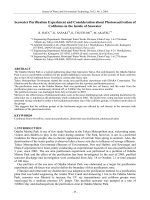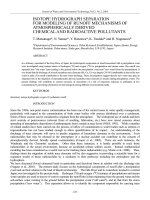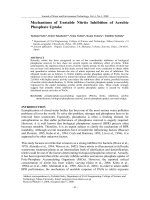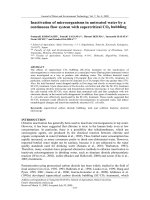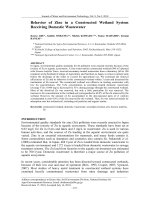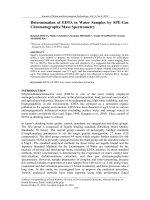Biochemical mechanisms of detoxification in higher plants
Bạn đang xem bản rút gọn của tài liệu. Xem và tải ngay bản đầy đủ của tài liệu tại đây (4.27 MB, 267 trang )
Biochemical Mechanisms
of Detoxification in Higher Plants
George Kvesitadze · Gia Khatisashvili
Tinatin Sadunishvili · Jeremy J. Ramsden
Biochemical
Mechanisms
of Detoxification
in Higher Plants
Basis of Phytoremediation
With 96 Figures and 8 Tables
123
George Kvesitadze
Gia Khatisashvili
Tinatin Sadunishvili
Durmishidze Institute of
Biochemistry and Biotechnology
David Agmasheneblis Kheivani, 10 km
0159 Tbilisi, Georgia
Jeremy J. Ramsden
Chair of Nanotechnology
School of Industrial and Manufacturing Science
Cranfield University
Bedfordshire
MK43 0AL, UK
j.ramsden@cranfield.ac.uk
ISBN-10 3-540-28996-8 Springer Berlin Heidelberg New York
ISBN-13 978-3-540-28996-8 Springer Berlin Heidelberg New York
e-ISBN 3-540-28997-6
Library of Congress Control Number: 2005932549
This work is subject to copyright. All rights reserved, whether the whole or part of the
material is concerned, specifically the rights of translation, reprinting, reuse of illustrations,
recitation, broadcasting, reproduction on microfilm or in any other way, and storage in data
banks. Duplication of this publication or parts thereof is permitted only under the provisions
of the German Copyright Law of September 9, 1965, in its current version, and permission
for use must always be obtained from Springer. Violations are liable for prosecution under
the German Copyright Law.
Springer is a part of Springer Science+Business Media
springer.com
© Springer-Verlag Berlin Heidelberg 2006
Printed in Germany
The use of general descriptive names, registered names, trademarks, etc. in this publication
does not imply, even in the absence of a specific statement, that such names are exempt from
therelevantprotectivelawsandregulationsandthereforefreeforgeneraluse.
Product liability: The publisher cannot guarantee the accuracy of any information about
dosage and application contained in this book. In every individual case the user must check
such information by consulting the relevant literature.
The instructions given for carrying out practical experiments do not absolve the reader from
being responsible for safety precautions. Liability is not accepted by the authors.
Typesetting and Production: LE-T
E
X, Jelonek, Schmidt & Vöckler GbR, Leipzig
Coverdesign: design&production, Heidelberg
Printedonacid-freepaper 2/YL–543210
Preface
In our new millennium environmental problems have become closely
linked to everybody’s life: the condition of the environment has become
one of the most vitally important parameters determining the continuing
existence of mankind. The inexorable and seemingly permanent increase
of technogenic contaminants in all ecological niches creates danger for all
nature. Confronted with this situation, the rational use of the capabilities of
higher plants, which even today, after the anthropogenic destruction of so
much flora, still cover more than 45% of the land, to absorb and detoxify
contaminants of amazingly diverse chemical structures might be a signifi-
cant route to solve the problem. As an inherently biological principle of
environmental remediation, phytoremediation is the closest to nature
among the various available technologies, and is especially effective
against widespread contamination of low concentration (chronic pollu-
tion), which, it is now recognized, is a far more serious challenge to the
overall world environment than the dramatic accidents that the media are
so fond of highlighting.
This book has been written to provide an overview of the fundamental
aspects of phytoremediation, to summarize existing understanding of the
mechanisms of detoxification of environmental contaminants in plants; to
describe the principles of the practical realization of these modern tech-
nologies; to show the degree of disturbance to plant cell homeostasis under
the action of toxicants at different doses; and to rationally evaluate the eco-
logical potential of plants.
There is no doubt that all kinds of ecotechnologies based on mechanical,
chemical, physical and biological principles of environmental preservation
are important at different levels, such as within an individual company or
chemical plant, a district, country, or the entire globe. Worldwide envi-
ronmental defense calls for the partnership of all countries, since pollution
rarely respects political boundaries, and purely national programme are
unlikely to be very effective. The creation of international projects in envi-
ronmental preservation should lead to closer international cooperation on
issues extending beyond the physical and biological environment, which is
expected to have indirect benefits in many fields.
VI Preface
The aim of the authors is to convey the framework upon which the com-
paratively new multidirectional discipline of phytoremediation is based.
The new and selective use of vegetation for the decontamination of pol-
luted sites from organic and inorganic contaminants includes several as-
pects of plant physiology, plant biochemistry, organic and inorganic chem-
istry, microbiology, molecular biology, agronomy, engineering, etc.
The essence of phytoremediation lies in understanding the pathways
along which environmental contaminants enter plant cells, and then how
those cells deal with the xenobiotics. The preferred fate for organic con-
taminants is to be transformed into molecules that can enter the regular
metabolic channels of the plant; in other words, the proper metabolism of or-
ganic contaminants actually could provide nutrition to the plant. Depending
on the conditions, however, especially the dose of the contaminant, it may
merely be conjugated with a suitable endogenous compound available
within the cell and temporarily passively stored.
In order to understand the mechanisms of degradative transformation in
higher plants, only a small number of enzymes need to be considered, chief
among which are the cytochrome P450-containing monooxygenases, per-
oxidases and phenoloxidases. It is very important to realize that a plant cell
is not a miniature factory, in the way that some bacteria are. An individual
cell has a limited capacity to eliminate a xenobiotic contaminant. Xenobi-
otic-induced changes in gene expression and cell ultrastructure are dis-
cussed in this book. Despite this limitation, phytoremediation technologies
can be successfully applied since plants can rapidly grow and multiply to
occupy large volumes.
This book has a distinctively practical aim and is intended to serve as a
working handbook for anyone involved in setting up phytoremediation de-
fenses in order to improve environmental quality and hence the quality of
life for human beings. The authors’ credo, however, is that this work will be
far more effective with a deeper appreciation of the molecular mechanisms
within the plant cell underlying the process and its overall limitations.
The authors express their sincere thanks to Prof. Friedhelm Korte (Mu-
nich Technical University, Germany) for his long-term scientific collabora-
tion from which this book has profited to a great extent. It is also their
pleasure to express thanks and appreciation to Dr Elly Best (U.S. Army En-
gineer Research and Development Center, Vicksburg, Mississippi, USA)
for her critical reviewing of the individual chapters and for making useful
suggestions. Authors express their thanks to Mrs Enza Giaracuni for having
made sense of our highly convoluted and overwritten drafts and produced a
pristine final typescript.
Tbilisi, August 2005 Giorge Kvesitadze
Table of contents
1 Contaminants in the environment 1
1.1 Environmental contaminants 1
1.1.1 Pesticides 3
1.1.2 Dioxins 8
1.1.3 Polychlorinated biphenyls (PCBs) 10
1.1.4 Polycyclic aromatic hydrocarbons (PAHs) 11
1.1.5 Phthalates 12
1.1.6 Surfactants 13
1.1.7 2,4,6-Trinitrotoluene (TNT) 15
1.1.8 Chlorinated alkanes and alkenes 16
1.1.9 Benzene and its homologues 19
1.1.10 Heavy metals 20
1.1.11 Gaseous contaminants 25
1.2 Migration of contaminants into different
ecological systems 32
1.2.1 Migration of contaminants between soil and water 33
1.2.2 Migration of contaminants between water and air 35
1.2.3 Migration of contaminants between soil and air 37
1.2.4 Geographical migration of contaminants 38
1.2.5 Biotic migration of contaminants 40
1.2.6 Local contamination of ecosystems 43
2 Uptake, translocation and effects of contaminants in plants 55
2.1 Physiological aspects of absorption and translocation
of contaminants in plants 55
2.1.1 Absorption of environmental contaminants
by leaves 55
2.1.2 Penetration of contaminants into roots 61
2.1.3 Penetration of contaminants into the seeds 65
2.1.4 Translocation of environmental contaminants
in plants 66
VIII Table of contents
2.2 The action of environmental contaminants on the plant cell 78
2.2.1 Changes in cell ultrastructure 78
2.2.2 Changes in the activities of regular metabolism
enzymes 97
3 The fate of organic contaminants in the plant cell 103
3.1 Transformation of environmental contaminants in plants 103
3.2 Excretion 108
3.3 Transformation 110
3.3.1 Conjugation with endogenous compounds 110
3.3.2 Degradation pathways 120
3.3.3 Enzymes transforming organic contaminants 133
4 The ecological importance of plants for contaminated
environments 167
4.1 Plants for phytoremediation 171
4.2 Phytoremediation technologies 185
4.2.1 Phytotransformation 189
4.2.2 Phytoextraction 190
4.2.3 Rhizofiltration 192
4.2.4 Rhizodegradation 192
4.2.5 Hydraulic control 193
4.2.6 Phytostabilization 193
4.2.7 Phytovolatilization 193
4.2.8 Cleaning of the air 194
4.3 Transgenic plants in phytoremediation 198
4.4 The cost of phytoremediation technologies 202
4.5 Phytoremediation – an effective natural tool
for a healthy planet 204
References 209
Index 245
Acronyms
ADNT Aminodinitrotoluene
ATSDR Agency for Toxic Substances and Disease Registry
BTEX Benzene, toluene, ethylbenzene, xylenes
2,4-D 2,4-Dichlorophenoxyacetic acid
DCA 3,4-Dichloroaniline
DDT Dichlorodiphenyltrichloroethane
DNOC Dinitro-o-cresole
EPA United States Environmental Protection Agency
FDA United States Food and Drug Administration
GSH Glutathione
GST Glutathione S-transferase
HMX Octahydro-1,3,5,7-tetranitro-1,3,5,7-tetrazocine
IARC International Agency for Research on Cancer
IPSC International Programme on Chemical Safety
MTBE Methyl tert-iarybutyl ether
PAH Polycyclic aromatic hydrocarbons
PCB Polychlorinated biphenyl
PHC Petroleum hydrocarbon
POP Persistent organic pollutant
RAM Risk assessment and minimization
RDX Hexahydro-1,3,5-trinitro-1,3,5-triazine
2,4,5-T 2,4,5-Trichlorophenoxyacetic acid
TAT Triaminotoluene
TCDD 2,3,7,8-Tetrachlorodioxybenzodioxin
TCE Trichloroethylene
TNT 2,4,6-Trinitrotoluene
TSCF Transpiration stream concentration factor
VOC Volatile organic compound
WHO World Health Organization
1 Contaminants in the environment
1.1 Environmental contaminants
The constant increase of environmental contamination by chemical com-
pounds is one of the most important and unsolved problems burdening
mankind – a XXI century sword of Damocles. The sources of chemical
pollution are divided into two types, natural and anthropogenic, i.e., origi-
nating from human activity. Natural contamination may result from ele-
mental processes such as the emission of poisonous gases during a vol-
canic eruption, the washing of toxic elements out of ore during floods or
earthquakes, as well as the metabolic activity of all kinds of organisms,
excreting toxic compounds, etc. In comparison with nature, however, the
human contribution to environmental contamination is much more impres-
sive. As a result of urbanization, the unpredictable growth of industry and
transport, the annual increase of chemical production, military activities,
etc., man has created a multi-barrelled weapon that finally appears to be
targeted back onto him.
More than 500 million tons of chemicals are produced annually in the
world. In different ways, huge amounts of these hazardous substances or
toxic intermediate products of their incomplete transformations are accu-
mulated in the biosphere, significantly affecting the ecological balance.
Nevertheless, members of the plant kingdom (lower microorganisms and
higher plants) can assimilate environmental contaminants, and be success-
fully directed to remove toxic compounds from the environment, providing
long-term protection against their environmental dispersal in ever increas-
ing doses [278]. Lately, many ecological technologies have been elabo-
rated, targeted to minimize the flow of toxic compounds to the biosphere
or to control their level or state [505]. Despite the definite positive effect
from the realization of these technologies, the intensive flow of toxic com-
pounds to the biosphere is still increasing.
2 1 Contaminants in the environment
Toxicity (from the Greek toxikon – poison for oiling arrows) is the abil-
ity of natural and synthetic chemical compounds, in doses exceeding nor-
mal pharmacological levels, to induce disruption of normal vital processes.
In cybernetic terms, one would say that the organism’s essential variables
are pushed towards their limits, and sometimes beyond them. Toxicity is
revealed in different ways. At the contemporary stage of development of
medicine, biology and chemistry toxicity does not have a precise defini-
tion. Operationally, the term toxicity can be defined as the action of com-
pounds characterized by the ability to suppress or significantly inhibit the
growth, reproduction or definite functions of some organisms, or particular
organs within them [287].
Undoubtedly, the great majority of chemically synthesized compounds
such as plant protection and pest control agents (pesticides), paints and
varnishes, solvents and emulsifiers, petroleum products, products of ap-
plied chemistry, many chemicals widely used in the polymer industry
(monomers, dyes, plasticizers, stabilizers, etc.), products of the pharma-
ceutical industry, surfactants, refrigerants, aerosols, explosives, heat-
generating elements of nuclear power stations, conservation agents and
packing materials, are toxic. Some of these products are characterized by a
much higher toxicity than otherwise comparable natural compounds. Ex-
amples of exceptions (highly toxic compounds of natural origin) are
cyanogenic glycosides, glucosinolates, glycoalkaloids, lectins, phenols,
coumarins and some other secondary metabolites of plants. Toxins of mi-
croorganisms are specific poisons elaborated by both prokaryotic and eu-
karyotic microorganisms. These toxins are often polypeptides varying in
molecular mass and may contain up to one hundred thousand amino acids
[118]. Low-molecular-mass organic compounds are also encountered as
microbial toxins. In spite of their high toxicity, these compounds exist in
nature at such low concentrations in comparison with anthropogenic toxic
compounds that they cannot be considered as contaminants.
Waste often contains contaminants of low toxicity. Industrial wastes are
substances (chemical compounds) that cannot be processed within the
framework of existing technology, or their further treatment is economi-
cally inefficient [287]. The main point of any technological process is an
application of different types of action such as physical (e.g., mechanical),
chemical, biological, or combinations thereof. Often, after exhausting all
possible effects of one type of treatment, the use of other types may allow
further transformation. Due to the intensification of industry, driven by an
exponential growth of population, wastes have become extremely numer-
ous. Wastes often serve as a source for the development of toxic micro-
flora, which can transform them into hazardous contaminants. The wastes
of agriculture and the food industry can be classified as substances of low
1.1 Environmental contaminants 3
toxicity. Even some components of food (alcohol, fats, aldehydes, secon-
dary metabolites, other ingredients) might be considered as compounds
having a (very low) toxicity, although their consumption in small amounts
is harmless. The United States Food and Drug Administration (FDA) has
created and maintains a list of common plant toxins, and guidelines defin-
ing acceptable toxin levels. A number of medical supplies, including anti-
biotics, also belong to the category of substances of low toxicity.
In the remainder of this chapter, several classes of highly toxic envi-
ronmental contaminants and some individual compounds will be discussed
in more detail.
1.1.1 Pesticides
Pesticides, compounds for plant protection and pest control, are ranked as
the most widely distributed chemical contaminants of the environment in
the twentieth century. According to data compiled by the United States
Environmental Protection Agency (EPA) and the World Health Organiza-
tion (WHO), over 1000 compounds are used as pesticides, representing
compounds of many different chemical classes: carbamates, thiocar-
bamates, dipyridyls, triazines, phenoxyacetates, coumarins, nitrophenols,
pyrazoles, pyrethroids, and organic compounds containing chlorine, phos-
phorus, tin, mercury, arsenic, copper, etc. Millions of tons of pesticides are
produced and used annually in close association with agriculture. Many ar-
ticles, reviews and books are devoted to pesticides [375, 376]; here only
the sources of pesticides, their distribution and toxicity will be reviewed.
Pesticides are generally divided into the following groups according to
their type of action:
− Acaricides (also called miticides), agents used against mites.
− Algicides, to combat algae, applied for the sanitary control of lakes,
channels, water pools, water reservoirs, etc.
− Antifouling agents, against different organisms growing on the under-
water surfaces of boats and ships.
− Attractants, the means to entice parasites, insects and rodents into spe-
cial traps.
− Bactericides or biocides, disinfectants and sanitizers for the annihilation
of some pathogenic microorganisms.
− Defoliants, the means for rapid defoliation, generally used to facilitate
the harvest of useful crops.
− Desiccants, chemicals promoting desiccation of tissues, e.g., the roots of
undesirable plants.
4 1 Contaminants in the environment
− Fumigants, the means to produce gas or vapor to destroy pests in buil-
dings or in soil.
− Fungicides, agents against blights, mildews, mold and rusts.
− Herbicides, to combat weeds and toxic vegetation.
− Insecticides, chemicals for the annihilation of harmful insects and other
arthropods.
− Molluscicides, agents for protecting submarine surfaces from snails and
slugs.
− Nematocides, the means to protect from nematodes, worm-like micro-
scopic organisms that feed on plant roots.
− Ovicides, chemicals to damage the eggs of insects and mites.
− Pheromones, agents against the propagation of insect populations.
− Plant growth regulators, to deliberately change the growth rate, flower-
ing and reproducibility of plants.
− Repellents, agents to repel pests, including insects (especially mosqui-
toes) and birds.
− Rodenticides, the means for protection from rodents.
Due to the widespread and long-term application of pesticides in agri-
culture, soils, ground waters and reservoirs in many areas are now heavily
contaminated. The toxicity of pesticides makes them hazardous when in-
corporated into the food chain.
Examples of the most widely distributed pesticides are given below:
O
PO
O
O
RO
OR
OR
O
PO
O
S
C
2
H
5
C
2
H
5
O
2
N
Alkylphosphates Parathion
NH
Cl
C O CH
2
O
C C
CH
2
Cl
Barban – 4-chloro-2-butynyl (3-chlorophenyl)carbamate
1.1 Environmental contaminants 5
CH
3
NH
2
C
O
O
NH
C
O
O CH
3
Betanal – 3-((methoxycarbonyl)amino)phenyl(3-methylphenyl)carbamate
S C NH
S
CH
2
CH
2
NH C
S
S
Mn
n
Maneb – ((1,2-ethanediyl-bis(carbamodithioato))(2-))manganese
Alkylphosphates (triethylphosphate) are strong inhibitors of acetylcholi-
nesterase. This affects the transmission of signals to nerve endings via the
acetylcholine receptor. The decrease of enzymatic activity leads to an ac-
cumulation of symptoms of diseases such as sialorrhea, pulmonary edema,
colics, diarrhoea, nausea, weakening of sight, rise of blood-pressure, mus-
cular spasms and convulsions, speech disturbance, and paralysis of the
respiratory tract. A similar clinical picture is observed in the case of phos-
phates and carbamates administered at intentionally increased doses.
Organochlorine insecticides (e.g., chlordane, dieldrin, lindane, DDT)
typically penetrate into the human organism through the digestive tract or
the skin [207]. When the membranes of nerve cells are damaged by pesti-
cide action, their permeability for osmotic transport of Na
+
-flow is main-
tained. Hence, their rest potential after excitation either does not return to
its initial level, or is decreased. These organochlorine compounds severely
change the excitability of nerve cells. At low concentrations axons are
damaged; higher concentrations also cause the damage of sensory neurons.
Chlordane and dieldrin are, moreover, clearly carcinogenic.
Cl
Cl
Cl
Cl
Cl
Cl
Cl
Cl
O
Cl
Cl
Cl
Cl
Cl
Cl
Cl
Cl
Cl
Cl
Cl
Cl
Chlordane Dieldrin Lindane
6 1 Contaminants in the environment
Dichlorodiphenyltrichloroethane (DDT) is an extremely active insecti-
cide. This compound was first synthesized in 1874, and since 1930, when
its insecticidal properties were established, was widely used against the
malaria transmitter, the Anopheles mosquito [276].
Cl
C
Cl
C
H
Cl
Cl
Cl
Dichlorodiphenyltrichloroethane (DDT)
The practically unlimited application of DDT led to its worldwide dis-
tribution. Its high solubility in fat favored its incorporation into food
chains. As a result, in the terminal steps of food chains the concentration of
DDT is typically increased almost a million times, e.g., starting from rain-
water and ending in human milk [162].
DDT is well absorbed by clays, is accumulated in humus rich in pine
needles, where it is dissolved in the wax of the needles. Destroying many
organisms, this compound negatively influences ecosystems. It is a typical
contact poison, rapidly penetrating through the skin. DDT induces apop-
tosis in human mononuclear cells in vitro and is associated with increased
apoptosis in exposed children [373].
It induces DNA damage in blood cells [539], and adversely affects the
normal duty cycle of nerve cell membranes, as it depresses the response of
the Na
+
-pump, hence normal restoration of the resting potential does not
occur after excitation of the nerve; large amounts of DDT induce paralysis
of extremities. Maternal milk containing the insecticide can seriously dam-
age the health of a child or disturb latent reproductive capacity by penetrat-
ing into the gonads.
Under usual conditions, DDT slowly and partially decomposes. Under
aerobic conditions decomposition products are derivatives of dichloro-
ethylene, which are less toxic than DDT; under aerobic conditions the di-
chloroethane derivatives are formed, which are easily transformed into de-
rivatives of acetic acid [162].
Chlorinated herbicides have specific physiological effects on humans.
For example, 2,4-dichlorophenoxyacetic acid (2,4-D) and 2,4,5-trichloro-
phenoxyacetic acid (2,4,5-T) act typical for herbicides to a less extent than
their admixture with 2,3,7,8-tetrachlorodioxybenzo-p-dioxin (TCDD). The
toxicity of the latter compound is 500,000 times higher than that of 2,4-D.
1.1 Environmental contaminants 7
Even if the TCDD content in a herbicide is only 0.005 mg/kg, this concen-
tration cannot be considered as harmless, because TCDD exerts not only
very high toxicity under natural conditions, but is also extremely stable.
COOH
O CH
2
Cl
Cl
Cl
COOH
O
O
Cl
Cl
Cl
Cl
Cl
O CH
2
Cl
2,4-D 2,4,5-T 2,3,7,8-TCDD
In 1971, in the small town called Times Beach, Missouri about 10 m
3
of
technical oil was splashed onto the ground of a hippodrome to avoid dust
at horse races. Several days later the hippodrome was covered with dead
birds, and a day later three horses and a rider fell ill. 29 Horses, 11 cats and
4 dogs died within one month. After 3 months several adults and children
fell ill [90]. The authorities were forced to investigate and found dioxins
and furans at concentrations of 30–53 ppm in the ground. The technical oil
used at the hippodrome was waste from the industrial production of
2,4,5-trichlorophenol and contained TCDD. 2,4,5-Trichlorophenol is used
as an insecticide and also is a reaction component in the production of
2,4,5-T (“agent orange”). 2,4,5-Trichlorophenol and 2,4,5-T can be easily
transformed into TCDD by elimination of two molecules of hydrogen
chloride and two molecules of chloroacetic acid.
Dipyridyls, such as the herbicide paraquat, induce blisters and ulcers
even upon slight external contact with the skin [6].
N
+
N
+
CH
3
CH
3
CH
3
OSO
3
2
-
Paraquat
Paraquat may act synergistically together with iron to provoke Parkin-
son's disease [6]. After penetration into an animal, dipyridyls damage kid-
neys and liver and then cause fibrous changes in the lungs, often with le-
thal consequences. Due to their high toxicity, dipyridyls require especially
careful handling.
8 1 Contaminants in the environment
The so-called pyrethroid pesticides also have toxic characteristics and
are synthetic analogues of a widely distributed insecticide pyrethrin, a
natural compound found in chrysanthemums. Pyrethrins intended for in-
secticide use are modified to increase their stability. Synthetic pyrethrins
have toxic effects on the nervous system [475].
CH
3
C
CH
3
CH
CH
3
CH
3
C O
O
CH
3
CH
2
O
CH
CH
CH
CH
2
Pyrethrin
1.1.2 Dioxins
The group of polychlorinated dibenzodioxins and dibenzofurans, called di-
oxins is distinguished by an especially high toxicity [90]. These com-
pounds are always found as a complex mixture.
O
O
Cl
n
Cl
n
O
Cl
n
Cl
n
Polychlorinated dibenzo-
p
-dioxin Polychlorinated dibenzo-
p
-furan
n
is the number of chlorine atoms and varies
from 4 to 8 for the entire molecule
The basic sources of dioxins are chemical factories producing chloror-
ganic pesticides, polychlorinated chlorobenzenes, solvents for a number of
chlorine-substituted alkanes (mainly dichloroethane, trichloroethane, eth-
ylene chlorohydrin), and chlorine substituted polymers (above all polyvi-
nyl chloride). Dioxins are also found in the gas used in the chlorination of
water supplies. Polychlorinated contaminants are formed as admixtures
during the interaction of chlorine with carbon (e.g., of electrodes and aerial
oxygen). It should be stressed that dioxins constitute a serious hazard to
the environment and human health [90].
According to the rate of environmental contamination by dioxins the
pulp and paper industry is the second worst after the chemical industry.
For the production of paper from woody raw material, lignin must be
1.1 Environmental contaminants 9
eliminated to leave just the cellulose. This delignification process implies
the interaction of phenolic lignin fragments with chlorine reagents result-
ing in the formation of dioxins or their precursors. During the standard
bleaching process of woody polysaccharides, chlorine or its derivatives are
used, leading to the formation of polychlorinated contaminants.
Dioxins are also formed in high-temperature chemical processes (in-
cluding garbage incineration) in which organic and inorganic compounds
with one or more atoms of chlorine (including molecular chlorine) partici-
pate. Automobiles are another source of dioxins. These compounds end up
in the exhausts along with the combustion gases from the engines of cars
working on fuel containing tetraethyl lead (antiknock agent) and 1,2-
dichloroethane (added to reduce lead accumulation inside the engine). Like
other polychlorinated compounds, dioxins do not undergo transformation
after entry into humans. Their penetration often leads to the development
of chloracne, a severe skin disease, followed by long-lasting open sores
and damage of the endocrine system, adversely affecting proper sexual de-
velopment and usually fatally affecting embryos. Dioxins cause immuno-
deficiency, increasing sensitivity to infectious diseases, and are of carcino-
genic nature. Comparison of the minimal lethal doses with the semi-lethal
doses of dioxins shows their high toxicity. The toxicity of TCDD is
3.1x10
-9
mol/kg, while for the toxin curare it is 7.2x10
-7
, for strychnine
1.5x10
-6
, for sodium cyanide 3.1x10
-7
, for diisopropyl fluorophosphate (a
chemical warfare agent) 1.6x10
-5
mol/kg. Only lethal doses of the toxins
formed by the pathogenic botulism bacteria (3.3x10
-17
) and diphtheria
(4.2x10
-12
) exceed the toxicity of dioxins [171].
In spite of their high resistance, dioxins do appear to undergo very slow
biodegradation. In the literature there are no data reporting the ability of
plants to transform dioxins, but some microorganisms are able to mineral-
ize these harmful toxic compounds. The eventual degradation of dioxin
molecules is conducted by the joint action of aerobic and anaerobic micro-
organisms. Anaerobes, in particular Dehalococcoides sp. strain CBDB1,
carry out reductive dehalogenation of dioxins [59] leading to the formation
of p-dioxins. The latter compounds undergo enzymatic transformation by
the aerobes Sphingomonas sp. RWI with participation of dioxygenases and
hydrolases, as a result of which the splitting of the aromatic ring is ob-
served (Fig. 1.1) [147]. Some microorganisms, for example, soil micro-
scopic fungi and actinomycetes, are sensitive to the effect of dioxins, and
the absence of these taxonomic groups of microorganisms in soil can serve
as a bioindicator of the level of contamination by dioxins [343].
10 1 Contaminants in the environment
O
O
O
OH
OH
OH
O
OH
O
OH
COO
-
OH
OH
COO
COO
OH
-
-
+
O
2
+
NADH
+
H
+
NAD
+
O
2
H
+
Dibenzo-
p
-dioxin
Dioxygenase
Dioxygenase
Hydrolase
H
2
O
H
+
2,2'3-Trihydroxy-
diphenyl-ether
2,3-Hydroxy-6-oxo-6-
(2-hydroxyphenyl)-
hexa-2,4-dienolate
Catechol
2-Hydroxymuconate
Fig. 1.1. Microbial degradation of dibenzo-p-dioxin
1.1.3 Polychlorinated biphenyls (PCBs)
PCBs, a family of over two hundred compounds, are characterized by an
extremely high toxicity among polychlorinated aromatic compounds. Due
to their high flame resistance, PCBs are used as anti-flash additives in elec-
tronics, printing equipment, transformer capacitors, packing materials, and
as plasticizers in plastics, and as liquid thermoformer components of many
technical oils. PCBs are antidusting agents of pesticides.
Cl
y
Cl
X
PCBs. Aroclor–1254 has x+y=5, for example
1.1 Environmental contaminants 11
Though PCBs are slightly soluble in water and have a high boiling
point, they are widely distributed in air, water and soil. The present general
environmental contamination with PCBs is connected with their wide ap-
plication. Despite strict restriction of the application of PCBs in industry,
they are found in large amounts in soils and sediments, and via this path-
way in water and air. Due to their high chemical stability and lipophilicity
PCBs tend to be stable under natural conditions and remain unchanged for
a long time. If a PCB molecule contains chlorine not exceeding 30% of its
total mass it can be more easily removed by organisms than PCBs with a
higher halogen content (60% or more) [162]. PCBs accumulate in plants
and animal tissue, are inserted into the food chain, and therefore are ulti-
mately dangerous for human health [206].
PCB toxicity increases proportionally with the increase in chlorine con-
tent. Poisoning by PCBs causes chloracne, changes the blood composition
and affects the liver and the nervous system. There is considerable evi-
dence for the carcinogenic nature of these compounds.
PCB residues are hard to annihilate. The best method is burning at a
temperature above 1200 °C. They belong to that category of substrates
whose application must undoubtedly be restricted. According to the litera-
ture, only a few bacterial strains are able to perform the full mineralization
of PCBs as a result of aerobic and anaerobic conversions [269]. This proc-
ess is slow compared with the rate of microbial or enzymatic degradation
of many natural and even synthetic compounds. Initially dehalogenation of
PCBs molecule takes place and the aromatic biphenyl rings become acces-
sible for the oxidizing enzymes that degrade toxic compounds to regular
cell metabolites. Data on the ability of plants to degrade PCBs are very ex-
iguous [76].
1.1.4 Polycyclic aromatic hydrocarbons (PAHs)
As PCBs, the aromatic hydrocarbons contain condensed rings. PAHs are
almost insoluble in water, have high boiling points and are difficult to de-
compose [162].
12 1 Contaminants in the environment
All these compounds have at least one cavity (marked by arrows) in
their molecular structure. This feature is a characteristic for many carcino-
genic compounds. No reliable information is available on PAH release on
an industrial scale. Compounds of this class are formed during combustion
of all kinds of fuel, and many natural products contain them. PAHs can be
found in pitches, bitumen, soot, and humus components of soil. They are
components of the exhaust gases of engines, combustion products of cook-
ing stoves or space heating furnaces, smoked foods, tobacco and a number
of other natural and anthropogenic products. PAHs are widely distributed
and very stable under practically any conditions, creating a real danger to
accumulate in living organisms at elevated concentrations.
Carcinogenicity of PAHs in mice has been reported [98]. After penetra-
tion of PAHs into the organism enzymes form epoxy compounds. These
compounds react with guanine and block DNA synthesis, inducing dis-
ablement of transcription processes, or leading to mutations, which often
promote cancer. There is substantial data in the literature indicating the po-
tential of microorganisms and plants to degrade PAHs to regular cell me-
tabolites [139, 450, 502, 504].
1.1.5 Phthalates
Phthalates, esters of phthalic acid, form another group of aromatic ring-
containing toxic compounds. These esters are used as softeners in the pro-
duction of polyvinyl chloride and other polymeric materials. Esters of
phthalic acid are widely used in the production of solvents, lubricants, pes-
ticides, lacquers and dyes, paper, perfumery, etc. [162].
1.1 Environmental contaminants 13
OR
OR
O
O
Ester of phthalic acid
In plastics, these esters may comprise up to 40% of the mass. Phthalates
are found in soil, air, and water. The primary source of phthalate distribu-
tion is the loss during their production processes. Besides, in time they
slowly diffuse from plastics. Esters of phthalic acid are characterized by
slight solubility in water and insignificant volatility. Upon burning, they
volatilize. Phthalates are adsorbed onto organic materials in soils, leading
to their accumulation in water reservoirs mainly on sediments. They also
accumulate in sewage. Phthalates can be found in food products with arti-
ficial wrapping in very low concentrations (ppm).
Only an insignificant proportion of the ingested phthalates is absorbed
via the gastrointestinal tract. They affect the skin and mucous membranes,
slightly irritating them. Toxic effects of these compounds on organisms
have not been studied comprehensively, although there are indications that
the most widely distributed (80% of all phthalates used) compound, dioctyl
phthalate (bis(2-ethylhexyl) phthalate), is carcinogenic [160]. On the other
hand, the harmful action of phthalates on plants has been documented: it
causes chlorosis (fading of the green coloring of leaves). Obviously, in this
particular case the action of phthalates is connected with the disruption of
chlorophyll biosynthesis [162].
Phthalates undergo degradation by microorganisms and plant enzymes
[259]. As a result of bacterial action, the phthalic acid is formed initially
from phthalates that are decarboxylated by ring splitting after hydroxyla-
tion. At the end of this process succinate and CO
2
, or pyruvate and CO
2
,
completing the natural decomposition of glucose, are formed. The biologi-
cal degradation of a phthalate molecule lasts several weeks on average.
1.1.6 Surfactants
Surfactants or detergents (tensides) create huge problems of water pollu-
tion. They are used as washing enhancers, reducing water surface tension.
Their use is often followed by foaming [162]. Surfactants are organic
compounds with both hydrophilic and hydrophobic moieties, and they fall
into several distinct classes. The most widely environmentally distributed
14 1 Contaminants in the environment
surfactants are the alkylsulfonic acids, the sulfuric acid residue of which
forms the hydrophilic moiety:
R
C
R
OSO
3
-
In the case of the polyoxyethylenes, compounds of nonionic character,
alcohol groups form the hydrophilic part of the molecule. Polyoxyethylene
can form an ester with the residue of a fatty acid, or an ether with the resi-
due of a high-molecular-mass alcohol:
RCOO– (CH
2
– CH
2
O)
n
H RCH
2
O– (CH
2
– CH
2
O)
n
H
Ester Ether
Alkyl ammonium compounds contain positively charged quaternary
ammonium as the polar (i.e., hydrophilic) component. Therefore they are
called inversion soaps. Their bactericidal action is noteworthy.
R
1
– N
+
(CH
3
)
2
– R
2
Increasing industrial demands for surfactants and their intensive applica-
tion in everyday life has led to widespread accumulation of foam in rivers
and reservoirs. Foam hampers navigation, and the toxicity of surfactants
causes mass extermination of fish. Negative experience in surfactant ex-
ploitation in the 1950s forced the search for biodegradable surfactants.
Those having an unbranched chain, as e.g. nonionic detergents with alkyl-
benzene sulfonates, have this property [548]:
[CH
3
(CH
2
)
n
–C
6
H
4
–SO
3
–
]R
+
These compounds are furthermore characterized by low toxicities for
humans and fish [499]. Biotic disintegration of the chains in their mole-
cules is accomplished by β-oxidation, i.e., by splitting acetic acid residues.
Even very low concentrations (0.05–0.1 mg/l) of surfactants in rivers can
become toxic, however: surfactants adsorbed to sediments and waste-water
containing tensides can lead to the activation of toxic substances hazardous
for groundwater. It is clear that the search for tensides of biogenic origin
that can be rapidly and totally biodegraded must be continued and is of
prime importance.
1.1 Environmental contaminants 15
1.1.7 2,4,6-Trinitrotoluene (TNT)
A very toxic contaminant, TNT, is used as an explosive compound and in-
termediate in the production of dyes and photographic materials.
CH
3
NO
2
NO
2
O
2
N
2,4,6-Trinitrotoluene
The production and use of TNT for military purposes has led to its wide
distribution. TNT is one of the most toxic explosives in the military arse-
nal, and has contaminated thousands of hectares of land. TNT mobility in
soil is limited due to its strong adsorption onto soil particles.
TNT, assimilated via the digestive tract, skin and lungs, is accumulated
mainly in the liver, kidneys, lungs and adipose tissue, stimulating chronic
diseases [365]. According to EPA data, TNT is classified as a carcinogenic
substance of group C. In animals TNT is slowly metabolized via the reduc-
tion of nitro groups leading to the formation of nitroso derivatives, hy-
droxylaminodinitrotoluenes, aminodinitrotoluenes (ADNTs) and diami-
nonitrotoluenes. Besides, oxidation of the methyl group and formation of
nitro- and amino-derivatives of benzyl alcohol and benzoic acid may take
place. Some of these metabolites (mainly amino-derivatives) are conju-
gated with glucuronic acid [146]. Formation of nitroso and hydroxylamino
groups is the factor predetermining the toxic effect of TNT on an organism
[21]. These groups bind to cell biopolymers, including nucleic acids and
finally lead to chemical mutagenesis [408].
Microbial transformation of TNT usually begins with reduction of one
of the nitro groups. The enzymes that catalyse these reductions are non-
specific NAD(P)H-dependent nitroreductases [156]. Complete reduction of
nitro groups significantly reduces the mutagenic potential and toxicity of
TNT.
Microorganisms degrade TNT in the following ways:
− Elimination of nitrogen in the form of nitrite and further reduction of ni-
trite to ammonium under aerobic conditions.
− Reduction of nitro groups by nitroreductase under anaerobic conditions
and further aerobic metabolization of amino derivatives.
16 1 Contaminants in the environment
There are data indicating that TNT can serve as a terminal electron ac-
ceptor in the respiratory chain and that TNT reduction is coupled with
ATP synthesis [156].
Some strains of Pseudomonas and representatives of mycelial fungi are
able to utilize TNT as a source of nitrogen and carbon, and incorporate at-
oms of these elements in the skeleton of regular cell metabolism com-
pounds. This is a good example of how parts of toxic compounds can par-
ticipate in the vital processes of organisms. Phanerochaete chrysosporium
and some other strains of basidial fungi completely mineralize TNT. The
enzymes of basidial fungi easily degrade reduced metabolites of TNT. Due
to the high intra- and extracellular activities of woody polysaccharide-
degrading enzymes (cellulases, hemicellulases), and such oxidases as lig-
nin peroxidase, Mn-peroxidase, and laccasey the strains of Phanerochaete
chrysosporium are characterized by a high degradational potential.
The ability to absorb and assimilate TNT is intrinsic to different kinds of
plants. The aquatic plant parrot feather (Myriophyllum aquaticum) and the
alga stonewort (Nitella sp.) are used for the remediation of TNT-
contaminated soil and water. Enzyme nitroreductase, which reduces TNT
nitro groups, is active in other algae too, in ferns, and in several monocot
and dicot plants, e.g., poplar (Populus sp.) trees [151]. Transgenic tobacco
(Nicotiana tabacum) with the expressed gene of bacterial nitroreductase
acquires the ability to absorb and eliminate TNT from the soil of military
proving grounds [213].
1.1.8 Chlorinated alkanes and alkenes
Chlorine-substituted alkanes and alkenes (e.g., tetrachloromethane (CCl
4
),
dichloromethane (CH
2
Cl
2
), chloroform (CHCl
3
), dichloroethane (CH
2
Cl–
CH
2
Cl), vinyl chloride (CH
2
=CHCl), trichloroethylene (CCl
2
=CHCl), tet-
rachloroethylene (CCl
2
=CCl
2
), etc. deserve much attention among the
toxic derivatives of hydrocarbons. These substances are often used as sol-
vents or initial reagents in organic synthesis. Due to their high volatility,
solubility in water (equal to about 1 g/l) and mobility, chloroalkanes and
chloroalkenes are able to penetrate through the concrete walls of sewer
systems and enter groundwater. The lipophilic nature of these contami-
nants results in their accumulation in adipose tissues of animal organisms
and incorporation in food chains [162].
Tetrachloromethane is generally used for the synthesis of fluorine
chlorohydrocarbons and fat solvents. It is estimated that 5–10% of all tet-
rachloromethane produced is spread in the environment. Under aerobic
conditions (in the atmosphere and the superficial layers of reservoirs, rich

